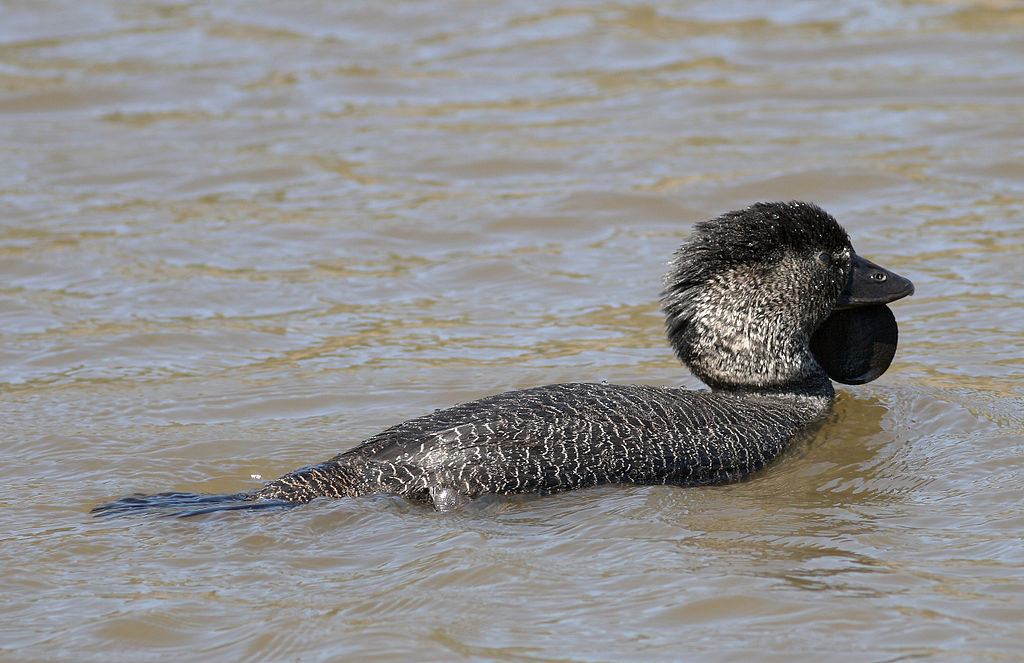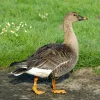
Musk Duck (Biziura lobata)
Species name
- Dutch name:
- Australische lobeend
- English name:
- Musk Duck
- German name:
- Lappenente
- French name:
- Érismature à barbillons
- Scientific name:
- Biziura lobata
Scientific classification
- Order:
- Anseriformes
- Family:
- Anatidae
- Onderfamilie:
- Oxyurinae
- Genus:
- Biziura
Description
- Description:
Male:
Almost entirely blackish brown with fine paler barring and speckling, apart from head, which nearly black on crown and nape, and slightly more obvious freckled buff on cheeks and neck; centre of belly whitish – buff, barred and freckled blackish – brown. Tail and wings, both above and below, black. Bill, legs and feet blackish grey. Large blackish grey pendulous lobe under bill, reaching to water, during display reaches size of golf ball.Female:
Considerably smaller then male (less than half average Weight); identical in plumage and bare parts, but with only rudimentary lobe.Juvenile:
Looks as female, but with yellowish on front half of lower mandible. Takes some years to attain full size lobe of males increasing in size at the same time.
- Behaviour:
They can be very aggressive in nest site defence, therefore in mixed collections they should be kept on a water area sufficiently large for other ducks to escape.
Standard Measurements
- Body Length (cm):
- The male (drake) of the Musk Duck measures approximately 66 centimeters. The female measures approximately 55 centimeters.
- Body Weight (grams):
- The male will weight about 1800-3100 gram. The female will weight about 1000-1900 gram.
The weight is notoriously variable and can only be used as indication!
- Subspecies:
It is the only living species of the genus Biziura.
A fossil species is known. The New Zealand lobster duck (Biziura delatouri).
- Habitat:
They are extremely aquatic and do best on large ponds of variable depth, with clean, deep water and plenty of natural food available in the form of marginal aquatic plants, while a muddy pond bottom will provide food items such as tubifex worms. Duckweed and small-sized seeds such as millet and canary seed mixtures are preferred to conventional waterfowl feeds, although wheat and floating pellets will be taken if natural food is scarce, for example in hard winter weather. Ample marginal vegetation (e.g. rushes, sedge, juncus reed) should be available for general cover and for nesting, with nesting rafts also provided.
- Note:
Musk ducks are very aggressive; large males may occasionally kill and eat ducklings or even very small teal. They require a seperate pen and should be kept on a large area (e.g. 800-1000 square metres or larger) of deep water with plentiful natural vegetation and associated natural aquatic animal life.
To reduce the risk of trauma to the female from agression by the male a pair may be kept in a divided pen, with a small-sized pop-hole in the connecting fence through which the female (smaller) may escape and the male (larger) not be able to follow.
May be fed grain, pellets and green food, with added animal food provided (e.g. diced liver, whitebait, crayfish, chopped prawns, mealworms).
This species is rarely bred in captivity. Breeding has been reported May to September in Australian collections They nest in close natural cover such as bulrushes, reeds or bankside vegetationand may also use rafts.
Rearing on water is suggested as with stiff-tailed ducks, and the ducklings should be reared seperately as even young ducklings will fight with each other if kept together. Ducklings will eat food dropped onto the water (particularly e.g. mealworms, crickets, finely chopped liver) or hand fed, but it takes time before they will eat from a dish. Consumption of starter crumbs may be encouraged by sprinkling animal food items onto the crumbs.
Within aviculture, breeding results with the Musk duck are very limited.
- Breeding:
- The female Musk Duck usually lays from 3-4 Light buff or pale greenish-white eggs and incubates them for 24-26 days.
- Artificial incubating:
The ideal relative humidity for incubating most waterfowl eggs is 55% (ground nesters) and 40% (cavity nesters). The temperature is usually 37.4°C. Set ventilation as recommended by the incubator manufacturer. Eggs must be turned, either automatically or by hand, a minimum of 4 times a day. As the duckling develops there is a loss of water from the egg and the air sac gets bigger. In normal development of an egg with a 24-26 days incubation, the air sac occupies about a third of it three days earlier. Cleanliness is vital and ideally eggs should be moved to a separate hatcher at this point, where the humidity should be increased to 65% and even higher once they have pipped internally.
- Bird banding:
- Recommended closed leg band ring size for the Musk Duck is 13 mm.The leg band ring can only be applied on a young diving duck at around 12-14 days old.
- It doesn't matter what leg that you band, but it's good to have a consistent system. Suggested: Left leg = Female, Right leg = Male
- Rearingfeed:
-



Floatable special rearing feed for all types of aquatic ornamental fowl - especially for the cultivation of trees as well as greening ducks.
This well-balanced complete feed with 20% protein content convinces above all by its good compatibility and forms the basis for visibly healthy growth from day one.
Made exclusively from wholesome and selected raw materials, Lundi Micro Regular is also ideally suited for the year-round feeding of waterfowl.
- Maintenance food:
-





Floating full food for all sea ducks, green ducks, eider ducks and geese, especially in the moulting and breeding phase ideally suited. Packed with wholesome raw materials, natural vitamins and trace elements, this performance food with a protein content of 30% forms the basis for lifelong vitality.

